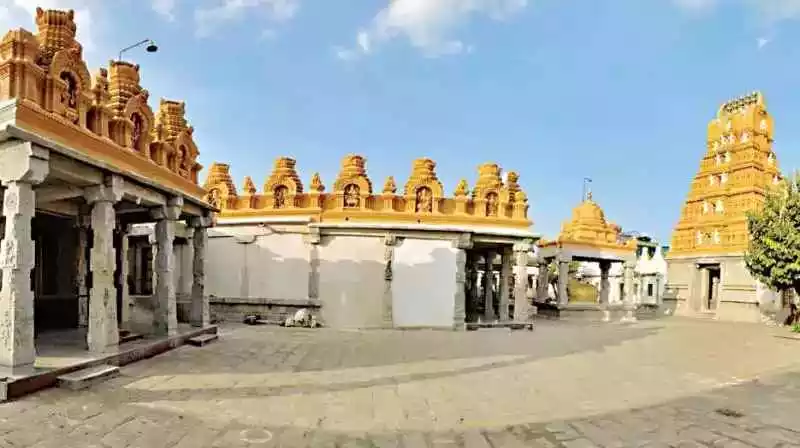Chamarajanagara: A Comprehensive Guide to Karnataka's Scenic District
Introduction
Chamarajanagara, located in the southern part of Karnataka, India, is a district rich in culture, history, and natural beauty. Known for its picturesque landscapes, diverse wildlife, and vibrant traditions, Chamarajanagara offers a unique blend of heritage and modernity. This article delves into various aspects of the district, including its geography, culture, cuisine, historical significance, notable personalities, and administrative setup.
Geography of Chamarajanagara
Chamarajanagara is nestled in the southern region of Karnataka, bordered by the districts of Mysuru to the northwest, Mandya to the north, and the state of Tamil Nadu to the east and south. The district covers an area of approximately 5,101 square kilometers, featuring a diverse topography ranging from plains to hills.
Climate and Natural Resources
The climate in Chamarajanagara is predominantly tropical, characterized by hot summers, moderate monsoons, and mild winters. The district receives an average annual rainfall of about 800-900 millimeters, primarily during the monsoon season from June to September. The Cauvery River, one of the major rivers in southern India, flows through the district, providing essential water resources for agriculture and daily use.
Flora and Fauna
Chamarajanagara is home to several protected areas and wildlife sanctuaries, including the Biligiriranga Swamy Temple Wildlife Sanctuary (BRT Sanctuary) and the Bandipur National Park. These areas are rich in biodiversity, housing a variety of flora and fauna. The region's forests are predominantly deciduous, with species such as teak, sandalwood, and bamboo. Wildlife enthusiasts can spot elephants, tigers, leopards, and numerous bird species, making it a significant ecological zone.
Cultural Heritage
Demography
As of the latest census, Chamarajanagara has a population of around 1.02 million people. The district is primarily rural, with agriculture being the mainstay of the economy. The population comprises various communities, including Vokkaligas, Lingayats, Scheduled Castes, and Scheduled Tribes, contributing to the district's cultural diversity.
Languages and Traditions
Kannada is the official language spoken by the majority of the population. The district's cultural fabric is woven with traditional music, dance, and folklore. Festivals such as Ugadi, Dussehra, and Diwali are celebrated with great enthusiasm, reflecting the rich cultural heritage of the region. Folk arts like Dollu Kunitha (drum dance) and Veeragase (a dance form depicting valor) are integral to the local traditions.
Cuisine of Chamarajanagara
Chamarajanagara's cuisine is a delightful blend of flavors, predominantly influenced by Karnataka's traditional culinary practices. The staple diet includes rice, ragi (finger millet), and jowar (sorghum), accompanied by a variety of vegetables and lentils. Popular dishes include:
- Ragi Mudde: A nutritious dish made from finger millet, often served with spicy curries.
- Bisi Bele Bath: A flavorful rice dish cooked with lentils, vegetables, and a special spice mix.
- Holige: A sweet flatbread stuffed with jaggery and lentil mixture, commonly prepared during festivals.
- Mysore Pak: A famous sweet made from gram flour, sugar, and ghee, originally from the nearby Mysuru region but popular in Chamarajanagara as well.
Historical Significance
Chamarajanagara has a rich historical background, with its roots tracing back to ancient dynasties that ruled the region. The district is named after Chamaraja Wodeyar, a prominent ruler of the erstwhile Kingdom of Mysore. Several historical monuments and temples in the district bear testimony to its glorious past.
Temples and Monuments
- Biligiriranga Hills (B.R. Hills): Known for the ancient Ranganathaswamy Temple, dedicated to Lord Vishnu, situated on top of the hills. The temple is a significant pilgrimage site and offers stunning views of the surrounding forests.
- Himavad Gopalaswamy Betta: A hilltop temple dedicated to Lord Krishna, often enveloped in mist, adding to its mystical charm.
- Bandalli Betta: Another notable hill with historical significance, featuring ancient inscriptions and relics.
Notable Personalities
Chamarajanagara has produced several notable personalities who have contributed significantly to various fields:
- Dr. Rajkumar: A legendary actor and singer in Kannada cinema, known for his versatile roles and melodious voice.
- Kengal Hanumanthaiah: The second Chief Minister of Karnataka, instrumental in the construction of the Vidhana Soudha, the state legislature building in Bengaluru.
Administration and Infrastructure
Administrative Divisions
Chamarajanagara district is divided into four taluks: Chamarajanagara, Gundlupet, Kollegal, and Yelandur. Each taluk is further subdivided into hoblis (clusters of villages), facilitating local governance and administration.
Governance
The district administration is headed by the Deputy Commissioner (DC), who oversees the implementation of government policies and programs. The district also has an elected Zilla Panchayat (district council) responsible for local self-governance.
Infrastructure Development
Chamarajanagara has made significant strides in infrastructure development, focusing on improving connectivity, education, and healthcare facilities. Key initiatives include:
- Road Connectivity: The district is well-connected by road, with National Highway 766 passing through it, linking it to major cities like Mysuru and Bengaluru.
- Education: Numerous schools and colleges, including government and private institutions, provide quality education to the district's youth.
- Healthcare: The district has several healthcare centers and hospitals, ensuring access to medical services for its residents.
Tourism Potential
Chamarajanagara's scenic beauty, rich biodiversity, and cultural heritage make it a promising tourist destination. Key attractions include:
- BRT Wildlife Sanctuary: A haven for wildlife enthusiasts, offering opportunities for safari tours and bird watching.
- Bandipur National Park: Part of the Nilgiri Biosphere Reserve, known for its diverse wildlife and conservation efforts.
- Hogenakkal Falls: A breathtaking waterfall on the Cauvery River, located near the border with Tamil Nadu, popular for its natural beauty and boat rides.
Suggested Diagram
Conclusion
Chamarajanagara is a district that embodies the essence of Karnataka's rich cultural heritage and natural beauty. From its lush forests and wildlife sanctuaries to its historical temples and vibrant traditions, the district offers a unique experience for residents and visitors alike. As infrastructure and tourism potential continue to grow, Chamarajanagara is poised to become an even more significant contributor to the state's cultural and economic landscape.
